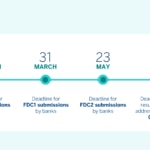The first climate stress tests for European banks have arrived
In January 2022, the European Central Bank (ECB) launched the first stress test for European banks using climate criteria. Ana Rubio, the Head of Financial Regulation at BBVA, and Antoni Ballabriga, the Global Head of Responsible Business at the bank, help us to better understand exactly what these tests are.

What are the climate stress tests and who conducts them?
Every two years, European banks undergo a European Banking Authority (EBA) stress test. In 2022, the ECB is adding a new test that incorporates climate criteria. So far, “the European supervisor has various lines of work underway on this subject, including periodic evaluation of the guides on supervisors’ expectations and thematic inspection of banks,” Ana Rubio explained. This year, in addition to this framework for action, “the first stress test to assess banks resistance to different scenarios of climate change will be tested.” It is a process that is “in its infancy,” Antoni Ballabriga added.
What do the tests consist of?
The ECB has divided the exercise into three modules: i) a questionnaire on banks’ capacity to carry out the climate stress tests; ii) a comparative analysis to assess the sustainability of the bank’s business models and their exposure to companies that produce the most emissions; and iii) a bottom-up stress test. To ensure proportionality, smaller banks will not be required to include projections for the stress tests.
Specifically, “the test will use macrofinancial scenarios based on those put together by the Network of Central Banks and Supervisors for Greening the Financial System (NGFS).These scenarios reflect possible climate policies in the future and take into account physical risks like rising temperatures, drought and flooding, and short- and long-term risks associated with the transition toward a greener economy,” the ECB indicated.
Therefore, in the words of Ana Rubio, it is a “very ambitious exercise”, as it includes a qualitative part that focuses on evaluating the banks’ internal procedures, a comparative analysis of banks in terms of the sensitivity of their income and their exposure, and an exercise to analyze the impact of the various scenarios on lending portfolios.” Furthermore, it analyzes both physical risks like those associated with specific scenarios of drought and flooding, as well as the transition risks that come more generally from the process of transitioning toward a more sustainable economy. Finally, “as it is a new exercise, there are no prior experiences to support us, and different countries and regions are doing tests with different methodologies, which we believe will end up converging,” she explained.
When and how will the results be published?
The exercise will take place in the first half of 2022. In March, the banks sent their first templates to the supervisor to be assessed. The ECB will publish aggregate data - not bank by bank - in July.

What does it mean for banks?
The BBVA expert in regulation indicates that: “Banks face very significant challenges when it comes to this exercise.” First, because “they need very detailed aggregated customer data, a type of data that banks do not usually have, and their exposure to climate risk.” Second, “the modeling needed for a climate stress test is completely new.” For example, it is the first time that a model is made on how an increase in temperature can affect the different economic sectors, and how this also affects the quality of lending portfolios.
In this sense, Ana Rubio explained that: “Banks are making great efforts to develop these new methodologies.” Even the ECB has called the test “a learning exercise for banks and supervisors, designed to identify vulnerabilities and best practices.” For this reason, future exercises are expected to progress toward a certain level of methodological convergence.
Similarly, Antoni Ballabriga said, “This is a learning process for everyone - also for supervisors and banks themselves. Methodologically speaking, it is a very new reality and there are no methodologies or models for which we can say, this is what works.”
How will it impact the financial sector?
The ECB has said that this initial exercise will not have direct quantitative repercussions on the supervisory assessment process and therefore, on capital requirements for banks.
In this regard, Antoni Ballabriga indicated that: “the results that will be published in a few months will not be comparable among banks because there will be diverse approaches” when it comes to sending their information to the supervisor.
“It is also not expected that the banks will use these results for their internal management. We still need to wait for convergence toward the best methodology, refinement of the scenarios, and the use of more detailed data from portfolios,” said Ana Rubio. All of this will help “to know how prepared banks are to face the effects of climate change.”